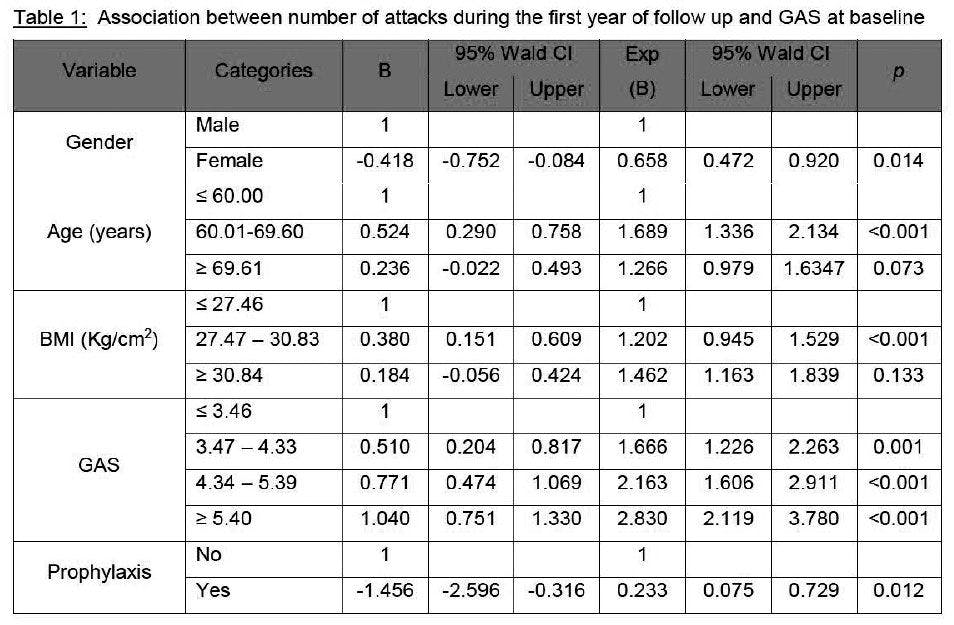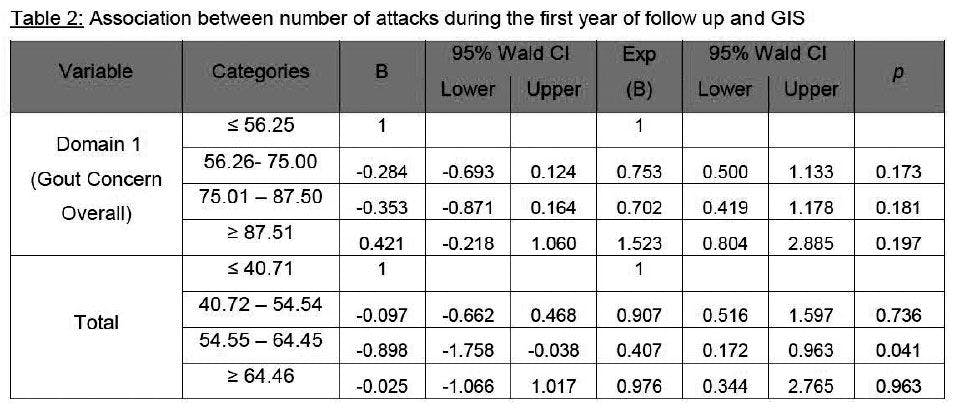Gout activity score trumps gout impact subscales in predicting gout flares: a prospective study using data from the Nottingham nurse-led gout study
Sandra Chinchilla (1,2), Michael Doherty (3), Abhishek Abhishek (3)
Affiliation(s):
1. Biocruces Health Research Institute, Barakaldo, Biskaia, Spain
2. University of the Basque Country (UPV/EHU),Lejona, Vizacaya, Spain
3. Academic Rheumatology, University of Nottingham, Nottingham, United-Kingdom
Background: Gout activity score (GAS) is a recently developed composite measure of disease activity in gout. It was developed and validated in a secondary care population, and its predictive validity in a primary care population has not been examined. The Gout Impact Scale (GIS), a part from the Gout Assessment Questionnaire (GAQ 2.0), has been used as disease specific measure of quality of life (QoL) in gout. GAS correlated moderately with GIS scales in a cross sectional study.
Objectives: The objectives of this study were to examine the correlation between GAS and individual subscales of GIS, and to examine the predictive validity of GAS and GIS subscales.
Methods: Data were used from a previous study where 517 participants with at least one gout flare in the previous year were identified from local GP practices in and around Nottinghamshire, and randomized to nurse-led or continuing GP-led care. Assessments were undertaken at 12 and 24 months. This study was approved by the local Ethics committee. GAS was calculated as described using the formula from Scirè et al, GAS3-step-c, with the data on number of attacks in the previous 12 months, current serum uric acid, patient reported visual analogue scale, and number of tophi. GIS was calculated as described by Hirsch et al, and is composed of the total score and five scales, specifically, Gout Concern Overall, Gout Medication Side Effects, Unmet Gout Treatment Need, Well-being During Attack and Gout Concern During Attack. Higher scores on GAS and GIS indicate more active disease and greater impact on QoL.
Mean and standard deviation (SD), n (%) were used for descriptive purposes. The correlations between GAS and GIS were examined using Spearman’s correlation. The associations between number of attacks, GAS and GIS where performed using Poisson’s regression. This was adjusted for gender, age, BMI, use of prophylaxis and GAS in quartiles. STATA version 15 was used for data analysis, and p<0.05 was statistically significant.
Results: At baseline, there were 517 patients, 262 in the GP group and 255 in the nurse-led group. At all-time points (i.e. baseline, year 1, year 2), there was a strong (≥ 0.37) and statistically significant correlation between GAS and Gout Concern Overall subscale of GIS. The rest of domains of GIS presented moderate to small correlations, with similar results when stratified by study group. The predictive validity of GAS, GIS, and incident gout attacks was examined only in the GP group, as treatment adjustment in the nurse led group will affect the gout flare frequency in the short and long-term. After adjusting for covariates such as age, sex, body mass index, and flare prophylaxis, higher GAS quartiles (Q) associated with gout flares. The Rate Ratio (95%CI) for number of gout flares was 1.66 (1.23-2.26), 2.16 (1.61-2.91), and 2.83 (2.12-3.78) for 2nd, 3rd, and 4th quartiles of GAS, with first quartile referent. Higher scores on gout concern overall subscale of GIS, and total GIS score did not associate with greater number of gout flares.
Conclusions: GAS correlates with gout concern overall subscale of GIS. However, GAS has significantly better predictive validity for incident gout flares than GIS. The findings of this study suggest that GAS has the potential of being used as an outcome measure in clinical trials and clinical practice.

